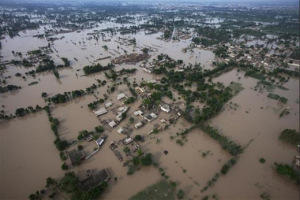Forecasting floodsBefore the deluge: improving flood forecasting
Summer 2012 was the third consecutive summer in which Pakistan has endured catastrophic floods; thirty million people were affected in 2010 and 2011; the summer 2012 floods affected 4.7 million more, killed nearly 500 people, and led to the evacuation of 350,000; Pakistan, stubbornly refusing to accept external assistance in flood forecasting, is not able to predict and prepare for natural disasters on its own

Pakistan hit by worst flooding in decades in recent years // Source: zubzip.com
When deadly floodwaters devastated Pakistan in early September, Georgia Institute of Technology Professor Peter Webster and Research Associate Kristofer Shrestha were not surprised. They had forecasted the disaster ten days in advance using a new hydrological model developed on campus. Webster has now sent that model to the World Bank, along with recommendations for saving Pakistani lives and infrastructure during future flooding disasters.
His comments on how to assist developing and emerging countries prior to natural disasters are also included in the current edition of Nature.
A Georgia Tech release reports that this is the third consecutive summer that Pakistan has endured catastrophic floods. Thirty million people were affected in 2010 and 2011. This summer’s floods affected 4.7 million more, killed nearly 500 people and led to the evacuation of 350,000. World emergency leaders have warned that Pakistan, which Webster says has been stubborn to accept external assistance, is not able to predict and prepare for natural disasters on its own. The country’s local weather warnings, with limited access to extended forecasts, are typically issued only a few days in advance and local populations have little time to act.
This is why Webster and colleagues took a closer look at forecasting the chances of a 2012 disaster. His system is based on a hydrological stream-flow model, terrain, and global precipitation forecasts. The model accurately predicted stream flow in the Indus River and its tributaries, which form Pakistan’s delta.
“The success of our model suggests a number of recommendations for the future, such as a Pakistani hazard prediction center and the creation of an extended operational flood system for the country,” said Webster, a professor in the School of Earth and Atmospheric Sciences. “Hopefully by working with the World Bank and the Pakistani government, we can form a long-term collaboration to reduce the catastrophe of future disasters.”
Another recommendation is using the system to create models of simulated floods during Georgia Tech-led workshops for Pakistani weather officials. Webster says it is imperative that a flood event forecasting system be integrated with disaster management and risk communication plans, especially with the recent increase in the number of floods affecting the country. As a result, Webster will travel to Islamabad next month to discuss some of the ideas at a workshop.
This is not the first time Webster has offered the system to a developing country. Following the 1998 floods in Bangladesh, Webster and his collaborators at Climate Forecast Applications Network (CFAN) created a partnership with the Bangladeshi government and the European Center for Medium-Range Weather Forecasts to develop an extended range flood forecasting system. The system has been in place since 2004.
CFAN was established in 2006 under Georgia Tech’s Enterprise Innovation Institute VentureLab Program. The company uses the Institute’s weather and climate research to improve probabilistic predictions.
“Integration of this new system can help determine the appropriate types and levels of responses for governments and communities,” said Webster. “This forecast system forms a solid base for an effective disaster risk reduction system.”
— Read more in Peter J. Webster, “Meteorology: Improve weather forecasts for the developing world,” Nature 493, no. 17 (3 January 2013) (doi:10.1038/493017a)
